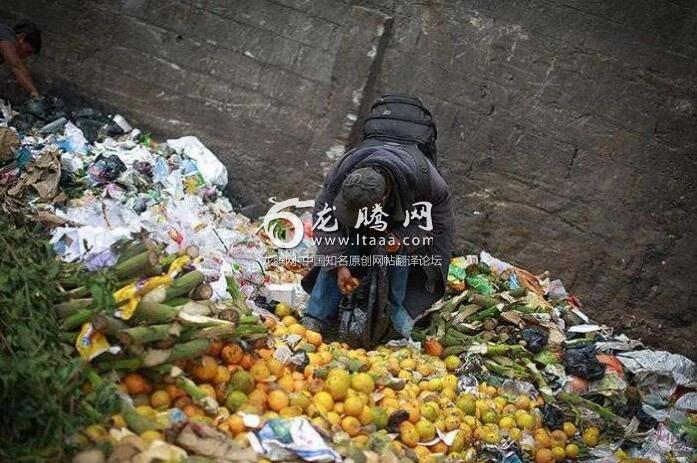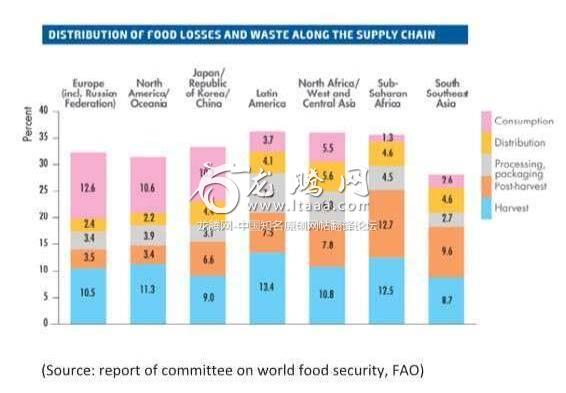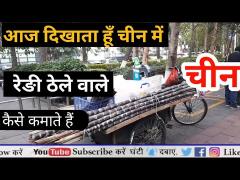研究表明:印度浪费的粮食等于英国的粮食消费总量 [印度媒体]
联合国开发计划署发表了一份令人震惊的报告。该报告指出“印度浪费的粮食等于英国的粮食消费总量”。在一个像印度这样街上仍有大量饿殍的国家,这并不是一个好数据。印度网友:肉类在印度价格高昂。通常家里不会烹饪肉类。按照美国素食主义者的标准,大部分的印度人基本上要被归类为“非素食主义者”。
India Wastes As Much Food As United Kingdom Consumes: Study
研究表明:印度浪费的粮食等于英国的粮食消费总量
An eye opening revelation had been made by United Nations Development Program (UNDP). It says “Indians waste as much food as the whole of United Kingdom consumes”. In a nation like India where millions still sleep hungry on streets, it’s not a good statistic.
联合国开发计划署发表了一份令人震惊的报告。该报告指出“印度浪费的粮食等于英国的粮食消费总量”。在一个像印度这样街上仍有大量饿殍的国家,这并不是一个好数据。
All the social functions and social joints in India (specially the northern and central parts), for instance weddings, canteens, hotels, social and family functions, households, spew out so much food.
印度的所有社交宴会和餐馆(特别是在印度北部和中部地区),比如举行婚礼、日常就餐、酒店用餐、社会与家族宴会、家庭用餐,都会丢弃大量粮食。
According to UNDP, up to 40 per cent of the food produced in India is bound to get wasted. About 21 million tonnes of India’s entire wheat produce are wasted and 50 per cent of all the food across the world meets the same fate. Such a situation raises a concern that food ‘never reaches the needy’ (UNDP). In fact, according to the agriculture ministry, Rs 50,000 crore worth of food produced is wasted every year in the country.
根据联合国开发计划署的报告,印度有高达40%生产出来的粮食是准备拿来浪费的。印度的小麦生产总量中有2100万吨遭到了浪费,而在全世界,有50%的粮食遭遇到了相同的命运。这种情况引发了粮食“永远都无法到达穷人手中”的担忧(联合国开发计划署语)。事实上,根据农业部门的统计,在这个国家,每年大约有价值5000亿卢比被生产出来的粮食遭到了浪费。
India ranks 63 among 88 countries in Global Hunger Index (GHI, UN data). Wastage of food is not only indicative of hunger, climate change or pollution, but also of many other economic glitches in the economy, such as inflation. Our culture and traditions are also playing a lead role in this drama where only government policies may not be termed responsible for any such wastage. In India, the bigger the wedding, the larger the party and the more massive the waste is expected to be.
印度在全球饥饿指数中位列88个国家的第63名。粮食浪费不仅与饥饿、气候变迁或污染相关,也与经济领域的诸多其他经济问题相关,如通货膨胀。我们的文化和传统也在这一过程中扮演了主要角色,而在其中,仅有政府政策可能无法控制此类浪费。在印度,婚礼规模越大,宴会的规模就越大,而将被浪费的粮食数量也越多。
Food Wastage Records
粮食浪费记录
● In a nation where millions of people do not have access to clean drinking water around 25 per cent of fresh water used to produce food is ultimately wasted. It will be shocking for many of us to know that if we calculate the figures in cubic kilo meters, this is a bit more than an average river flowing in India.
在一个数以百万计的民众无法获得干净饮用水的国家,大约有25%的淡水被用于生产粮食,从而最终遭到浪费。令我们中的许多人震惊的是,如果我们用立方千米作为单位来计算的话,这比一条在印度流淌的中等规模的河流流量相当。
● Even though the world produces enough food to feed twice the world’s present population (a US department of agriculture estimate), food wastage is ironically behind malnourishment of the billions of people. The number of hungry people in India has increased by 65 million. A figure which is higher than population of few major powers of the world, like France.
虽然整个世界生产了足够满足全世界现有人口两倍所需的粮食(按照美国农业部的估计),讽刺的是,粮食浪费仍然与数以十亿计人口的粮食短缺问题并存。印度饥饿人口的数量已经增长了6500万。这一数字要高于世界上少数几个强国的人口,比如法国。
● Acres of land are deforested to grow food. Approximately 45 per cent of India’s land is degraded primarily due to deforestation, unsustainable agricultural practices, and excessive groundwater extraction to meet the food demand. Though during last two years India has retained and somehow made it possible to increase its forest area by more than 14,000 hectares (second largest after China).
大量土地上的森林遭到砍伐,以种植粮食。印度大约有45%的土地出现了水土流失的现象,这主要是因为森林砍伐、不可持续的农业耕作方式和为了满足种植粮食所需而抽取过量地下水。虽然在过去两年时间里,印度已经维持了现有林地数量,并尽可能地将森林面积增加了超过1.4万公顷(位列中国之后排名第二)。
● A nation which has its third largest imports are edible oils. Around 300 million barrels of oil, which has been used to produce food is ultimately wasted, due to wastage of such food.
这个国家的第三大进口商品是食用油。大约有3亿桶的油——被用于生产食品——因为该类食品的浪费而最终遭到了浪费。
Way Forward
前进的方向
The Minister of Food Processing, Harsimarat Kaur had said, “My ministry works as a catalyst. It has the potential for doing a couple of things which are the need of the hour. Firstly, bring down food wastage. Food is being wasted at the harvest point and during transportation. If the same food which is wasted can be processed, it would mean it could either be available in raw form or in bottled form at a price which is affordable to the common man.”
食品加工部长Harsimarat Kaur曾经指出:“我的部门的工作就是充当催化剂。它有着完成当下亟需解决之事的潜力。首先,降低粮食浪费。粮食在收获期间和运输过程中遭到了浪费。如果这些被浪费的粮食能够得到处理,这将意味着它可以以粗加工或装瓶的方式以低价向普通民众提供粮食。
In the figure given above it can be observed that entire South Asia wastes 2.7 per cent of food during processing, noticeable part is that South Asian figures are majorly influenced by India’s data. This even raises a concern over the quality and process that is used in South Asian region.
从上面给出的数据中,可以发现整个南亚在处理过程中浪费了2.7%的粮食,而值得注意的是南亚的这一数据主要是受到印度数据的影响。这甚至引发了人们对于南亚地区所使用粮食处理工艺水平的担忧。
Food wastage cripples a country’s economy to an extent that most of us are unaware. If food is wasted, there is so much waste of water used in agriculture, manpower and electricity lost in food processing industries and even contributes to deforestation. Taking all of into consideration, the actual worth of money per year in India from food wastage is estimated at a whopping Rs. 58,000 crore to over Rs. 96,000 crore.
粮食浪费现象损害了一个国家的经济,其程度是我们大部分人所未曾意识到的。如果粮食被浪费了,那么就会出现农业中的用水、食品加工业中的劳动力和电力的大量浪费,甚至还会造成进一步的森林砍伐。考虑到各种因素,印度每年因为粮食浪费所导致的实际损失价值据估计达到了5800亿卢比至9600亿卢比这一庞大数字。
Some measures that the government needs to take include containing wastage in transportation, improve storage facilities (the cold storage chain is 50 per cent less than required and that too needs to be brought up to world standards said chairman of ASSOCHAM), food processing also needs to be sped up so food is saved and wasted less to feed more.
有些人认为政府需要采取相关措施,包括控制运输过程中的浪费、改进仓储设备(印度贸易与工业总会的主席指出,冷链设施被要求的要少50%,现在亟需引进世界标准),食品处理速度也需要加快,这样食品就能得以保存,从而减少浪费,养活更多的人。
While we may not be able to reduce food lost during production, we can certainly reduce food wastage at our personal level.
尽管我们可能无法减少在生产过程中损耗的粮食,但我们无疑能够从个人角度出发,减少粮食的浪费。
[–]svmk1987 2815 points 9 hours ago
If anyone is wondering, this isn't the usual wastage you see in the developed countries (due to excessive consumerism). We have a lot of serious issues with storage and logistics of agricultural produce, especially because a lot of the production happens in rural undeveloped places.
Also, we have weird laws which actually discourage investment in warehousing and storage of agriculture.
如果有人好奇的话,我会说这不是你在发达国家所见到的正常浪费水平(因为过度的消费主义)。我们在仓储、农业生产后勤方面存在着一系列严重的问题,特别是因为很多的生产过程是在农村的不发达地区进行的。此外,我们也存在着一些奇怪的法律,它们事实上并不孤立在农业仓储方面的投资。
[–]Americanathiest 771 points 9 hours ago
Yea it seems like the article is implying that most of this waste is due to inefficient technology at the gathering and storage levels rather than people just throwing good food away.
是的,看起来这篇文章是在暗示大部分的浪费是由采集和仓促层面上低效率的技术所造成的,而非是因为人们将粮食扔掉。
[–]Pywackt 138 points 7 hours ago
Despite all that, you don't spend a lot of money on food there. Not like Eastern Europe for instance.
尽管如此,你在那里不需要花费大笔的钱去购买粮食。不像东欧之类的国家。
[–]svmk1987 215 points 6 hours ago
True. Food is super cheap in India, probably because the government controls the prices for a lot of the food grains. Not everything is cheap. Fruits, for example, are quite expensive, and are generally pretty out of reach of poor people's diets. Even the middle class don't eat them too regularly.
的确。印度的食品超级便宜,这可能是因为政府管控了许多谷物粮食的价格。不是每件东西都是便宜的。比如说水果就非常贵,往往不会出现在穷人家的餐桌上。甚至连中产阶级都很少吃水果。
[–]thisistheslowlane 111 points 5 hours ago
Isn't the diet completely different too? Western foods are heavily protein based. That's essentially the bulk of the cost of any meal.
不是连日常食物都完全不一样吗?西方的食物是高蛋白的。基本上是在消费肉类。
India - 40% of Indians are vegetarians (9% of that 40% consume eggs).
而在印度,有高达40%的印度人是素食主义者(40%中的9%还消费蛋类)。
UK/USA - Only 3% of the population are vegetarian.
而在英国和美国,只有3%的人口是素食主义者。
[–]randomCAguy 62 points 3 hours ago
the 40% being vegetarian is somewhat misleading. Pretty much every non-vegetarian who isn't rich still only eats meat on occassion (maybe a couple times a month if they go out to a restaurant, or at weddings, etc).
40%的人口是素食主义者的数据在某种程度上是有误导性的。几乎每一个不富裕的非素食主义者也只是偶尔吃肉而已(可能一个月几次,如果他们下馆子或参加婚礼的话)。
Meat is expensive in India. It's not like it's cooked at home regularly. Most people categorized as "non-vegetarians" are basically vegetarians by US standards at least.
肉类在印度价格高昂。通常家里不会烹饪肉类。按照美国素食主义者的标准,大部分的印度人基本上要被归类为“非素食主义者”。
[–]dedasdude 18 points 5 hours ago
Meat is quite expensive here. Hence why most people even if non vegetarian cant eat meat. Its not affordable for most.. most villlagers consume rice n pulses and few veggies because thats very cheap.
肉类价格在这里非常高昂。这也是为什么大部分人即便是非素食主义者也没办法吃肉。大部分的人都负担不起。大部分的农村人只能消费大米和少量的蔬菜,因为这些东西都非常便宜。
[–]Fluttershy_qtest 15 points 4 hours ago
Yeah.
是的。
Beef is fairly cheap but it is also banned in a lot of states. Broiler chicken isn't too expensive if you're looking at a nutrition per gram perspective. Sadly poor people simply cannot afford to look at nutrition per gram, and all they can think of is feeling full. To this end carb is really cheap. And the Indian government generally subsidizes foodgrain and potatoes.
牛肉相对便宜,但很多邦都禁食牛肉。烤鸡价格不是太高,如果从单位重量的营养价值来看的话。可悲的是,穷人根本无法负担得起顾及单位重量的营养价值,他们只是想要饱腹。最终,碳水化合物真的是廉价的。而印度政府普遍会给予谷物和土豆补贴。
版权声明
我们致力于传递世界各地老百姓最真实、最直接、最详尽的对中国的看法
【版权与免责声明】如发现内容存在版权问题,烦请提供相关信息发邮件,
我们将及时沟通与处理。本站内容除非来源注明五毛网,否则均为网友转载,涉及言论、版权与本站无关。
本文仅代表作者观点,不代表本站立场。
本文来自网络,如有侵权及时联系本网站。
图文文章RECOMMEND
热门文章HOT NEWS
-
1
चाइना में रेडी और ठेले Local shops in china || L...
- 2
- 3
- 4
- 5
- 6
- 7
- 8
- 9
- 10
推荐文章HOT NEWS
-
1
चाइना में रेडी और ठेले Local shops in china || L...
- 2
- 3
- 4
- 5
- 6
- 7
- 8
- 9
- 10












